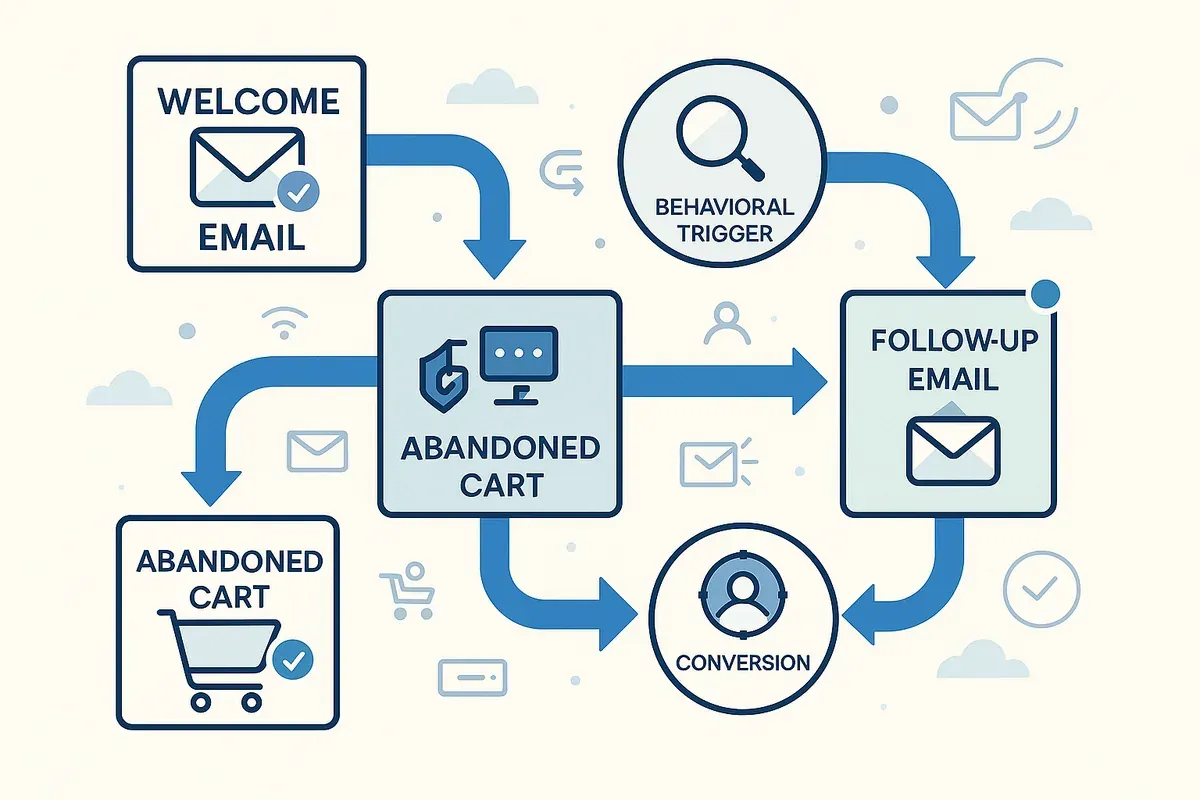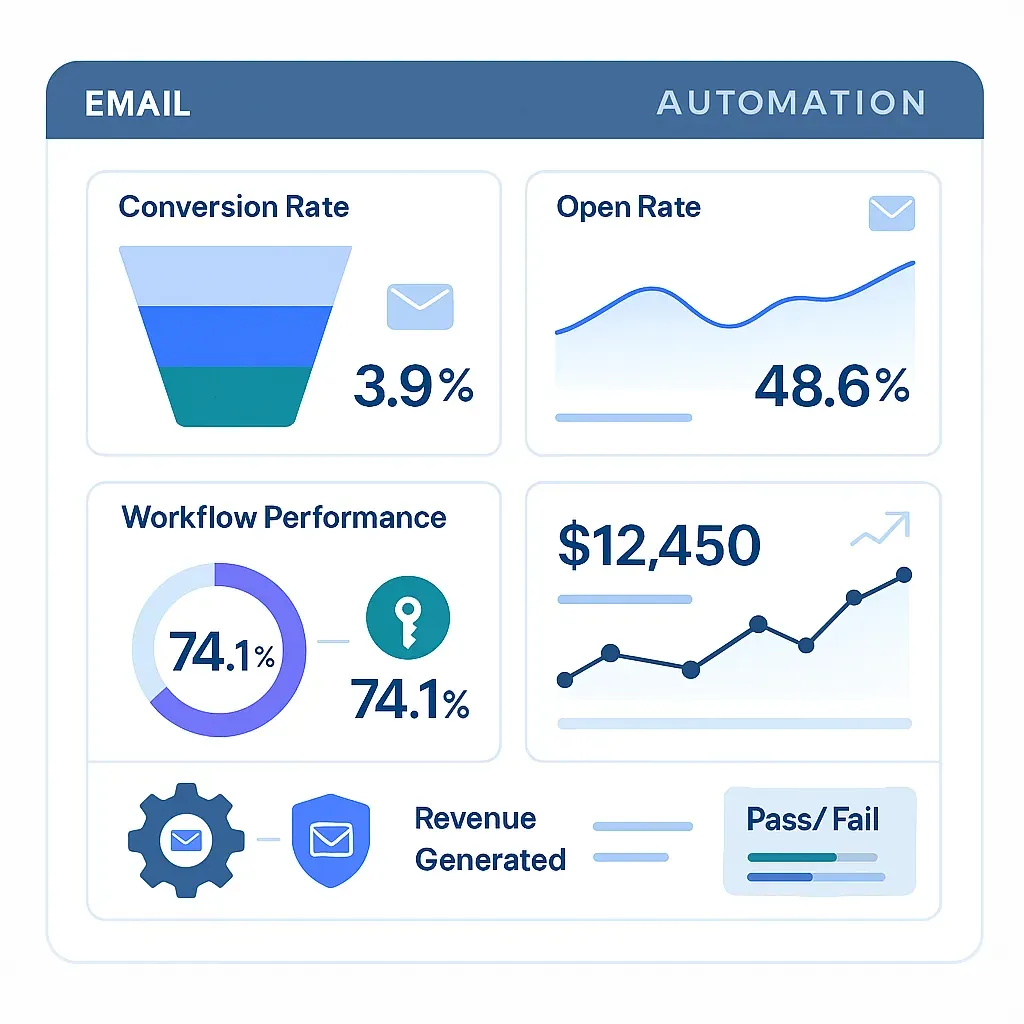Email Automation Workflows That Convert: Transform Your Marketing Strategy in 2025
Master email automation workflows in 2025 with proven strategies. Complete guide with actionable workflows that boost conversions.

Picture this: It's 3 AM, and while you're sound asleep, your email marketing system is busy nurturing leads, recovering abandoned carts, and converting prospects into paying customers. This isn't a fantasy—it's the reality for businesses leveraging email automation workflows effectively. With automated emails generating 320% more revenue than non-automated campaigns, the question isn't whether you should implement email automation workflows, but how quickly you can get started.
We've seen firsthand at Groupmail how businesses transform their marketing efficiency once they master email automation workflows. The challenge isn't lack of interest—it's knowing which workflows to implement first and how to optimize them for maximum conversions. In today's competitive landscape, manual email marketing simply can't scale with the personalized, timely communication customers expect.
💰 Business Impact: Automated emails drive 37% of all email-generated sales despite representing a fraction of total email volume, proving their exceptional conversion power.
TL;DR - Key Takeaways:
- Email automation workflows generate 320% more revenue than manual campaigns
- Welcome series, abandoned cart, and re-engagement workflows drive the highest ROI
- Behavioral triggers outperform time-based automation by 2-3x in conversion rates
- Proper segmentation increases automation effectiveness by up to 760%
- AI-powered optimization can improve workflow performance by 25% or more
What Are Email Automation Workflows?
Quick Answer: Email automation workflows are pre-designed sequences of targeted emails triggered by specific customer behaviors, dates, or conditions. These automated systems send personalized messages at optimal moments without manual intervention, delivering relevant content that nurtures leads and drives conversions across the customer journey.
Email automation workflows represent the intersection of marketing strategy and technology, enabling businesses to deliver the right message to the right person at precisely the right moment. Unlike traditional batch-and-blast email campaigns, these intelligent systems respond to customer actions in real-time, creating personalized experiences that feel natural and helpful rather than intrusive.
At Groupmail, we've observed that successful email automation workflows share three critical characteristics: they're behavior-triggered rather than time-based, they deliver genuine value at each touchpoint, and they adapt based on recipient engagement patterns. The most effective workflows don't just automate email sending—they automate relationship building.
The foundation of any successful email automation strategy rests on understanding your customer journey. According to the Federal Trade Commission's CAN-SPAM guidelines, all automated emails must include clear opt-out mechanisms and honest sender identification, making compliance an integral part of workflow design.
📊 Performance Insight: Automated emails achieve 52% higher open rates and 332% higher click ratescompared to scheduled campaigns, demonstrating superior engagement across all metrics.
Modern email automation platforms like Groupmail integrate seamlessly with external sending providers such as SMTP2GO and SendGrid, giving you complete control over deliverability while leveraging powerful automation features. This flexibility ensures your workflows reach inboxes consistently, regardless of volume or sending frequency.

Essential Email Automation Workflows for Conversions
Quick Answer: The highest-converting email automation workflows include welcome series (58% average open rate), abandoned cart recovery (45% open rate), and post-purchase follow-up sequences. These behavior-triggered campaigns consistently outperform broadcast emails because they deliver relevant content precisely when customers are most engaged and ready to take action.
Implementing the right email automation workflows can transform your marketing efficiency and revenue generation. Based on our experience at Groupmail and comprehensive industry research from eMarketer, certain workflows consistently deliver exceptional results across industries and business models.
Welcome Series Workflows
Welcome emails represent your first impression and set the tone for the entire customer relationship. A well-crafted welcome series doesn't just say "thanks for subscribing"—it introduces your brand story, sets expectations, and guides new subscribers toward their first meaningful interaction with your business.
The most effective welcome series follow a strategic three-email structure: immediate confirmation and value delivery, brand story and social proof, and clear next-step guidance with compelling offer. Research from MIT's Computer Science and Artificial Intelligence Laboratory shows that personalized welcome sequences increase engagement by 45% compared to generic alternatives.
| Workflow Stage | Timeline | Primary Goal | Key Elements |
|---|---|---|---|
| Email 1 | Immediate | Confirmation + Value | Welcome, lead magnet delivery, expectation setting |
| Email 2 | 2-3 days | Trust Building | Brand story, testimonials, popular content |
| Email 3 | 5-7 days | Conversion | Special offer, product recommendations, clear CTA |
Abandoned Cart Recovery
Shopping cart abandonment affects nearly 70% of online purchases, making recovery workflows essential for e-commerce businesses. However, effective abandoned cart sequences go beyond simple "you forgot something" reminders—they address potential objections, provide social proof, and create urgency without being pushy.
The optimal abandoned cart workflow timing follows proven psychological principles: first email within 1 hour (urgency), second email after 24 hours (social proof and benefits), and final email after 72 hours (scarcity and incentive). According to academic research on email marketing effectiveness, this sequence can recover up to 30% of abandoned purchases when properly executed.
Re-engagement Campaigns
Customer retention costs significantly less than acquisition, making re-engagement workflows crucial for long-term profitability. These workflows identify subscribers showing decreased engagement and deploy strategic content designed to reignite interest and prevent list churn.
🔒 Compliance Note: Under CAN-SPAM Act regulations, re-engagement campaigns must include clear opt-out options and cannot use deceptive subject lines, even when attempting to win back inactive subscribers.
Ready to implement this? Try Groupmail's drag-and-drop builder free—unlimited sending included.
Advanced Behavioral Trigger Strategies
Quick Answer: Advanced behavioral triggers leverage specific customer actions like page visits, download completions, or engagement patterns to deliver highly targeted email automation workflows. These sophisticated triggers can increase conversion rates by 200-300% compared to basic time-based automation because they respond to demonstrated interest and intent rather than arbitrary scheduling.
Moving beyond basic email automation workflows requires sophisticated understanding of customer behavior and the technology to act on those insights in real-time. Advanced behavioral triggers represent the cutting edge of email marketing, where AI-driven hyper-personalization meets precise audience segmentation to create truly individualized experiences.
Website Activity Triggers
Modern email automation workflows can respond to virtually any website interaction, creating seamless experiences that bridge digital touchpoints. When someone visits your pricing page multiple times, browses specific product categories, or spends significant time on particular content, these actions signal clear intent that smart workflows can capitalize on immediately.
The most sophisticated implementations track micro-interactions: time spent on page, scroll depth, exit intent, and return visit patterns. According to technical standards outlined in RFC 5322, these triggered emails must maintain proper message formatting and deliverability compliance while delivering personalized content at scale.
Engagement-Based Segmentation
Traditional email segmentation relies on demographic data, but behavioral segmentation focuses on actual customer actions and engagement patterns. This approach creates dynamic segments that automatically update based on recipient behavior, ensuring your email automation workflows stay relevant as customer interests evolve.
At Groupmail, we've implemented advanced campaign analytics that track engagement patterns across multiple touchpoints, enabling sophisticated automation rules that adapt to individual subscriber preferences without manual intervention.
Predictive Workflow Optimization
The next evolution in email automation workflows involves predictive analytics that anticipate customer needs before they explicitly demonstrate them. Machine learning algorithms analyze historical engagement data, purchase patterns, and behavioral signals to identify optimal timing, content, and frequency for each individual subscriber.
Research from academic institutions studying marketing automation effectiveness indicates that predictive optimization can improve workflow performance by 40-60% compared to static automation rules, particularly in complex B2B sales cycles where multiple touchpoints influence buying decisions.
🎯 Optimization Tip: Combine multiple behavioral triggers in single workflows for maximum relevance. For example, trigger based on both page visit AND time since last purchase to create highly targeted re-engagement sequences.
Measuring and Optimizing Workflow Performance
Quick Answer: Successful email automation workflows require continuous measurement and optimization using key metrics like open rates, click-through rates, conversion rates, and revenue per email. The most effective approach involves A/B testing individual workflow emails, analyzing customer journey analytics, and implementing feedback loops that automatically adjust based on performance data.
Measuring email automation workflow success goes far beyond traditional email metrics. While open rates and click-through rates provide baseline insights, true optimization requires understanding the entire customer journey and how each automated touchpoint contributes to broader business objectives.

Advanced Analytics Framework
The most successful email automation workflows utilize multi-dimensional analytics that connect individual email performance to broader business outcomes. This requires tracking not just immediate email engagement, but also downstream conversions, customer lifetime value changes, and long-term retention impacts.
Key performance indicators for email automation workflows include time-to-conversion metrics, workflow completion rates, and multi-touch attribution analysis. According to research from Google's AI division on automated email systems, sophisticated measurement approaches can identify optimization opportunities that simple open rate analysis would miss entirely.
A/B Testing Automation Sequences
Traditional A/B testing focuses on individual emails, but workflow optimization requires testing entire sequences against alternative approaches. This means comparing different welcome series structures, abandoned cart timing variations, and re-engagement content strategies to identify the highest-performing combinations.
The most effective testing approaches examine workflow-level metrics rather than individual email performance. For example, testing a three-email welcome series against a five-email version requires measuring total sequence conversion rates, not just individual email opens or clicks.
Continuous Improvement Processes
Email automation workflows perform best when they incorporate feedback loops that automatically adjust based on performance data. This might involve dynamic content selection, adaptive sending time optimization, or automatic list segmentation based on engagement patterns.
At Groupmail, our platform integrates with leading email service providers like SendGrid to provide real-time deliverability insights and performance optimization suggestions, ensuring your automated workflows continue improving over time without constant manual intervention.
| Metric Category | Key Indicators | Optimization Focus |
|---|---|---|
| Engagement | Open rates, CTR, time spent reading | Subject lines, send timing, content relevance |
| Conversion | Workflow completion, goal achievement | CTA placement, offer strength, sequence logic |
| Business Impact | Revenue per workflow, LTV improvement | Segmentation accuracy, personalization depth |
Key Terms
- Email Automation Workflow: Pre-designed sequence of targeted emails triggered by specific customer behaviors or conditions
- Behavioral Trigger: Automated email activation based on customer actions rather than predetermined timing
- Abandoned Cart Recovery: Automated email sequence targeting customers who added items but didn't complete purchase
- Lead Nurturing: Systematic process of building relationships with prospects through relevant, valuable content
- Conversion Rate: Percentage of email recipients who complete desired action (purchase, signup, download)
- Customer Journey Mapping: Visual representation of all touchpoints and interactions throughout customer relationship
- Segmentation: Division of email list into smaller groups based on shared characteristics or behaviors
- Drip Campaign: Series of pre-written emails sent automatically over time to nurture leads
- Re-engagement Campaign: Automated sequence designed to win back inactive or unengaged subscribers
- Marketing Automation Platform: Software that automates marketing tasks and personalizes customer experiences at scale
Frequently Asked Questions
How long should email automation workflows be? Email automation workflows should match your sales cycle length and customer decision-making timeline. B2C businesses typically use 3-7 email sequences, while B2B companies may extend to 10+ emails over several months. The key is providing value at each touchpoint rather than adhering to arbitrary length limits.
What's the best timing for automated email sequences? Optimal timing varies by workflow type and audience behavior. Welcome emails should send immediately, abandoned cart emails within 1 hour, and re-engagement campaigns after 30-60 days of inactivity. Industry research from multiple sources shows that behavioral triggers outperform time-based scheduling by 200-300% in conversion rates.
How do you handle email automation compliance? All automated emails must comply with CAN-SPAM Act requirements, including clear sender identification, honest subject lines, physical address inclusion, and functioning unsubscribe mechanisms. Additionally, respect recipient preferences and avoid overwhelming subscribers with excessive frequency.
Can small businesses effectively use email automation workflows? Absolutely. Small businesses often benefit more from automation than large enterprises because it allows limited marketing teams to deliver personalized experiences at scale. Modern platforms like Groupmail offer sophisticated automation features without enterprise-level complexity or cost.
What metrics matter most for workflow optimization? Focus on business-impact metrics like revenue per workflow, customer acquisition cost, and lifetime value improvement rather than just engagement metrics. While open rates and click-through rates provide useful insights, conversion rates and ROI determine actual workflow success.
How often should you update automation workflows? Review and optimize workflows quarterly, but make data-driven updates continuously. Monitor performance weekly and adjust underperforming elements immediately. Major workflow redesigns should align with product launches, seasonal changes, or significant customer behavior shifts.
Do automated emails work for B2B companies? Email automation workflows excel in B2B environments where longer sales cycles and multiple decision-makers require consistent nurturing. Academic research on automated marketing systems shows B2B companies using automation see 25% higher conversion rates than those relying solely on manual outreach.
What's the difference between workflows and campaigns? Email campaigns are one-time broadcasts sent to specific segments, while workflows are ongoing automated sequences triggered by subscriber behavior. Workflows build relationships over time, whereas campaigns typically focus on immediate actions or announcements.
Email automation workflows represent the future of effective marketing communication, delivering personalized experiences that build relationships and drive conversions without constant manual effort. The businesses winning in today's competitive landscape aren't just implementing automation—they're strategically designing workflows that add genuine value at every customer touchpoint.
Success with email automation workflows requires more than just setting up sequences and hoping for the best. It demands understanding your customers' journey, creating valuable content for each stage, and continuously optimizing based on performance data. The investment in proper setup and ongoing refinement pays dividends through increased efficiency, higher conversion rates, and stronger customer relationships.
Ready to transform your marketing with proven automation strategies? Start creating professional email campaigns with Groupmail's free account—no credit card required. Access unlimited sending and our live AI subject line generator today.




